PORTLAND, Ore. – It’s rare that a head coach is so explicit with their game plan, even after a match. But there may have been something in Saturday’s initial 30 minutes – a stalemate of patience between the Portland Timbers and Philadelphia Union – that compelled Giovanni Savarese to speak up when talking to the press after the night’s 3-0 victory – something that told him to reveal what, over that initial half-hour, his team was trying to do.
“They have fast players in the wings,” Savarese said, when asked when he again chose a three-center-back, no-winger lineup. “They had been very dangerous (in previous games), and we thought that we could find space going forward if we allowed them to get a little bit of space wide.”
Say you give a team space, though and they don’t take it. They don't commit to it. They don't throw people forward. They just ... kinda ... do nothing. They just sit. What are left with, then?
You’re left with Saturday’s first 30 minutes, ones that played out like a slog as much because of the Union’s lineup choices and posture as the Timbers’ approach. Alas, it takes two to tango, and when Union head coach Jim Curtin started a team that sacrificed two of his best midfielders (Alejandro Bedoya and Haris Medunjanin) and started two destroyers in their place, Portland’s wait-and-pounce approach produced a dire half hour.
Let’s break it down, starting with one of the first times Philadelphia held the ball in their base possessing shape. Before this fourth-minute moment, the game had mostly been about Timbers possession and the teams testing each other in transition. The Union had rarely been able to see how, in this phase of the game, Portland was going to set up.
Here, though, we see the midfield -- a compact three with David Guzmán at its base -- and the forwards. In this image, Samuel Armenteros is playing deeper, along side Diego Chara, in a place Diego Valeri would occasionally occupy during the half. When the two weren't staying high, one was staying very tight on the right of midfield. It was as if they'd been caught there while dropping back to help build play, and in the fact of some Philadelphia possession, they might as well stay and help out.
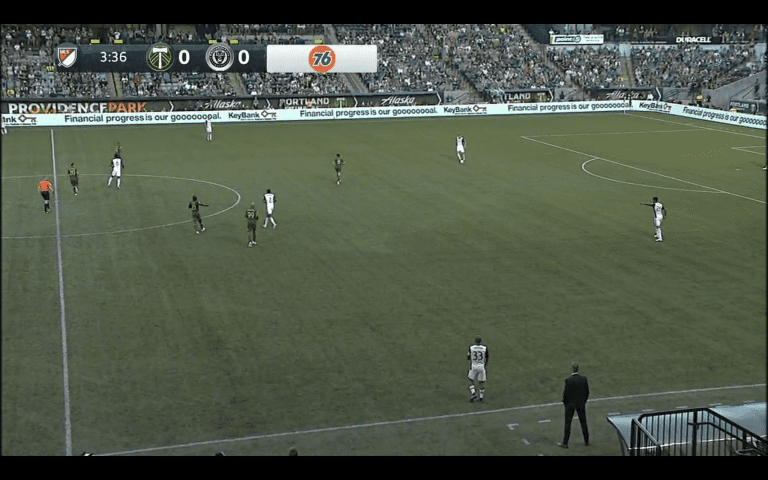
That's the wide space, Savarese was talking about, and it was consistently there for the Union to play into throughout the game's first half hour. Even before the Timbers' tactic became apparent, you could see how Portland was going to attack out of this shape, having tried to connect to Chara and Alvas Powell down the right flank in the game's first minutes. Give Philly that space, let them extend themselves into it, then trap them, win the ball, and have people like Armenteros and Valeri pounce.
Moments later, you could see one of the implications of that approach. As Philadelphia moved the ball from left-to-right (the result of which you see, here), left back Fabinho has all the space he'd want. But the Timbers are also set behind the ball. The four players the Union have high (their three attackers, plus midfielder Borek Dockal) are outnumbered, while the two deep midfielders Curtin's selected are crammed at the top of the packed Portland midfield.
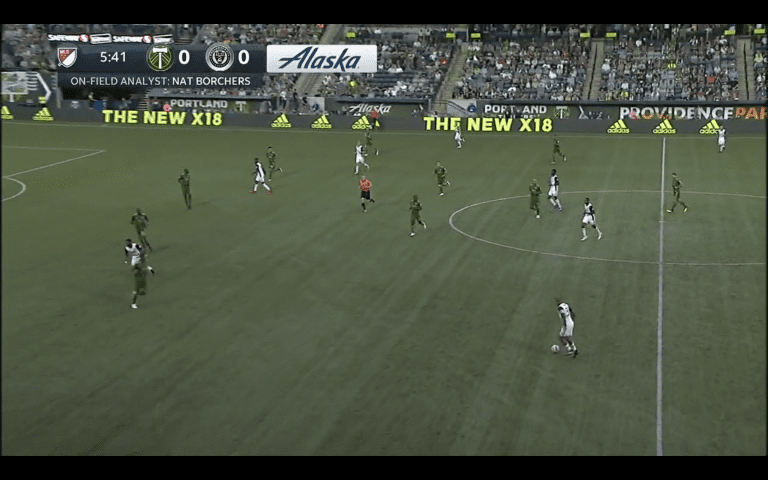
Under normal circumstances, Philadelphia would have Bedoya playing in central midfield, a player who is adept at getting forward, connecting play, and adding to numbers higher up the field. On this night, though, Philadelphia was given their left back on the ball, with no options, just waiting for the defense to rotate. Unless he started winning one-on-one battles, Fabinho represented an end game, not a build up.
It wasn't the worst situation to be in, though. Most boring? Maybe, but in terms of the scoreboard, it could have been worse. After all, think what would have happened if a Bedoya-like player was trying to get forward. Does Portland look susceptible to that kind of play? Not here, they don't. If anything, the idea of hitting cross after cross at targetman C.J. Sapong is appealing compared to advancing a midfielder, leaving Armenteros, Valeri and whoever else might get forward, and playing into Savarese's trap.
Over the match's first 35 minutes, the two sides would combine for eight shots and no goals. Once the game changed, though, they went on to put up 16 shots and three goals over the next 55 minutes, largely because of how the Timbers' tactical adjustments allowed the game to open up.
"We went a little bit higher with our (defensive) line and pressured a little bit higher," Savarese said, explaining the halftime adjustments that had started taking hold before intermission. "After we found the first goal, the guys were able to dominate in possession."
Consider this, a shot of the Timbers' base defensive shape early on. Where the ball is here on the field matters, but the fact the Timbers have let the Union have a level of comfort at this part of the field is telling, in and of itself. The back line is deep, as is the midfield. Valeri is pursuing the ball, but there isn't a system of support behind him, anticipating the next pass. As they've done with other opponents this season, Portland is allowing Philadelphia to access to certain spots.
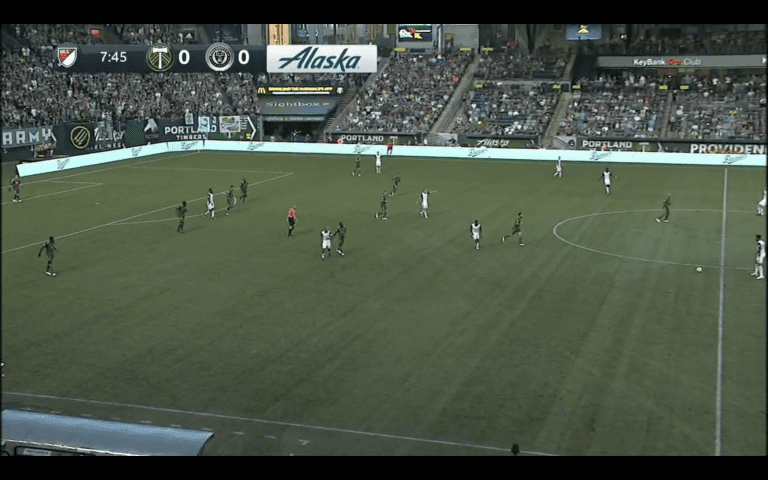
Fast forward to minutes after halftime, and look at the difference. Polo and Valeri and pressuring Union right back Keegan Rosenberry, forcing him into a negative ball. The back line is much higher, pushing the midfield line higher. And, the team is not as compact. The triangle that was staying tight in midfield throughout the first 30 minutes is opening up, trying to become a more active deterrent in Philadelphia's buildup phase.
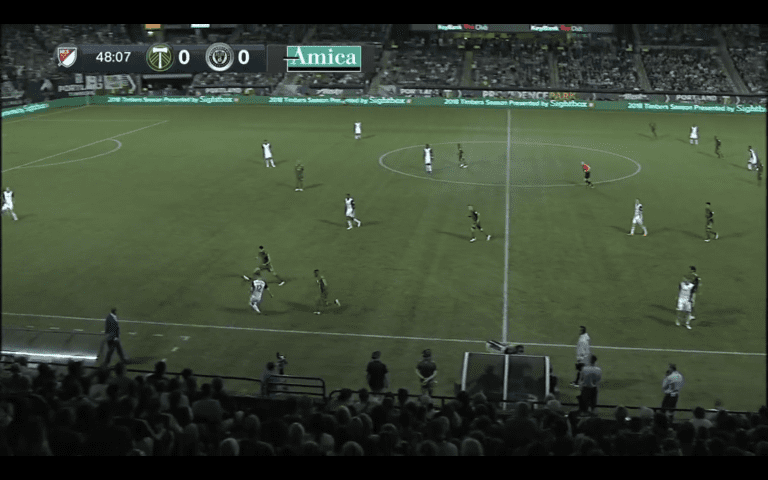
Moments later, that activity becomes even more dramatic. Rosenberry's ball sends the Union into their own end, playing from Jack Elliott to Austin Trusty at the back. But look who is there: Chara, pressing from his central midfield position, taking the game to the Union in their part of the field. Trusty had to play the ball back to Elliott, who turned and put the ball into touch after being harassed by Valeri.
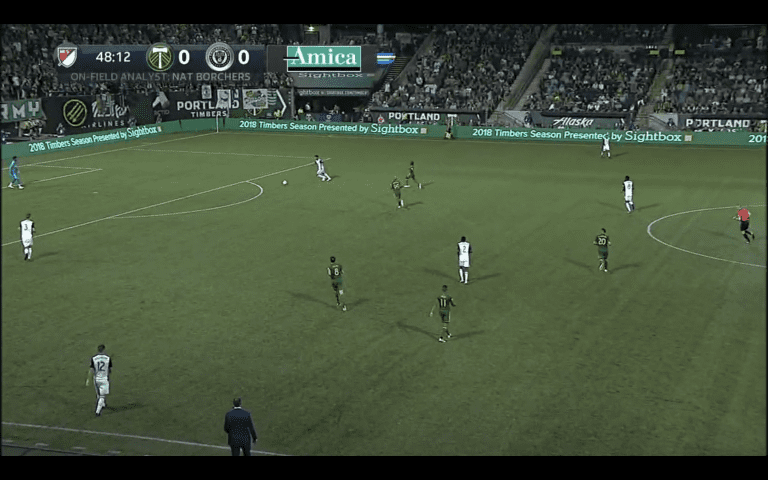
These changes may not have led directly to goals in the sense of Philadelphia turning the ball over, gifting the Timbers chances, but they opened up the game for Portland, allowed them to reclaim the ball quicker and with more space, and started giving the home side opportunities to leverage the advantages they had from the opening kickoff. The penalty kick Powell won to open the scoring didn't come from pressure, but it did come from Portland taking more of the ball and having more time to find dangerous spots. Likewise, the more open game meant more space to exploit ahead of the second penalty, when Powell found Valeri before Philadelphia's mistake in recovery. Even on the third goal, a more proactive game means you're more likely to earn set pieces in dangerous areas, set pieces like the one Valeri delivered onto the head of Guzmán.
The biggest question coming out of Saturday's win is less how the Timbers turned the game than why they didn't utilize those tactics from the opening kickoff. The changes Philadelphia made in midfield provide part of the explanation, but it's worth wondering whether at home, with superior talent, the team shouldn't have been more aggressive from the start. Would Bedoya and Medunjanin have made that much of a difference, had they been in the lineup?
Perhaps they would have, but there's another way to look at this scenario, one that doesn't come down to a pure talent-versus-talent measurement. Savarese saw a vulnerability in how the Union usually play, and he not only devised a way to exploit it but had a plan that reinforced the team's defense in the process. That's why, for the first time in three games, the team was able to keep a clean sheet, but it's also why, come the 30-minute mark, the team needed to adjust. At that point, the game was headed for a 0-0, with the plan Savarese crafted for a full-strength Union playing into the plans of Philadelphia's more defensive approach.
That his adjustments were so successful is a credit to Savarese. Whether those adjustments should have been made before kickoff will, thanks to Curtin's lineup decisions, forever be unknown.












